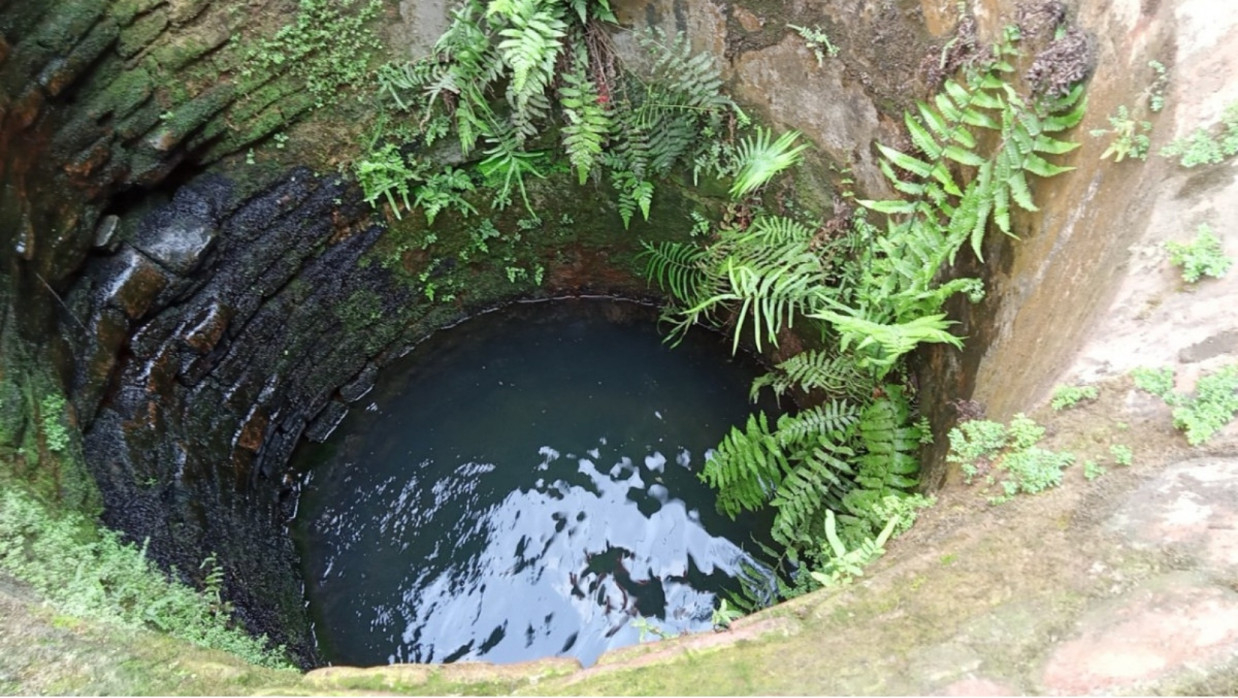Narinda’s Last Idara: A Century-Old Well Sustains a Community in Old Dhaka

In the heart of Old Dhaka, where time-worn walls bear the green patina of moss, a century-old well on Sharat Gupta Road in Narinda stands as a testament to history. Known as an idara, this well at house number 44 continues to serve a community of over 100 residents, offering water purer than the modern supply from Dhaka WASA. It carries not only water but also tales of Ayurvedic heritage, community resilience, and a bygone era.
A paatkua, as defined by Bangla Academy, is a rudimentary well, often lined with clay rings baked by potters, known as paat. These rings, stacked together, formed the structure of traditional wells. In contrast, an idara is a more sophisticated construction, lined with brick rings from base to top and equipped with a pulley system for drawing water with a rope and bucket. If the rope fell into the well, a hook akin to a fishing gaff was used to retrieve it. Historically, zamindars and royalty built idaras for their households, while paatkua or maitkua (wells in firm red soil requiring no lining) served common folk. In Bangladesh, groundwater is often accessible at shallow depths of 40 to 50 feet, making wells a practical solution in earlier times.
Before wells, people relied on ponds, canals, and rivers, which often dried up or became too polluted to drink during summer. Wells and idaras thus became vital, with many dating back centuries. In Dhaka, wells were once ubiquitous, but their use dwindled from the 1990s as piped water systems took over. Today, only a few remain functional in areas like Shakhari Bazar, Farashganj, Goalnagar, Sutrapur, Gendaria, and Thatharibazar.
The idara at house number 44 on Sharat Gupta Road is no ordinary well—it is part of a historic residence once known as Shakti Oushadhaloy, the Indian subcontinent’s first Ayurvedic medicine manufacturing company, founded in 1901 by Principal Mathuramohon Chakrabarty. The house, home to 22 families and over 100 residents, is a sprawling structure with a rich past. Four families, comprising about 30 members, rely exclusively on the idara for bathing and cooking, shunning Dhaka WASA’s water due to its unpleasant odour and occasional impurities.
The house’s grandeur is evident despite the ravages of time. A narrow path from the main gate leads to a brick-paved courtyard, where a Narayan temple, established in 1308 of the Bengali calendar (1901 CE), stands proudly. The main building features tall, double-storey columns resembling palm trunks, topped with ornate carvings and a triangular pediment reminiscent of ancient Greek architecture. A faded inscription on the first-floor veranda reads, “Shree Lalmohon Chakrabarty (Owner of Shakti Oushadhaloy),” affirming the legacy of its founder.
Shakti Oushadhaloy’s story is as remarkable as the idara itself. In the late 19th century, Mathuramohon, then a teacher at Jubilee School, fell gravely ill. Despite consulting renowned doctors in Dhaka and Kolkata, he found no relief. His recovery came under the care of Loknath Brahmachari in Baradi, who inspired him to abandon teaching and pursue Ayurvedic medicine. Following Brahmachari’s advice to “serve people using plants and herbs,” Mathuramohon founded Shakti Oushadhaloy. At a time when malaria devastated Bengal and quinine proved ineffective, his Amritarishto became widely known as “the infallible remedy for malaria.”
The idara remains functional, its circular opening, roughly 10 feet wide, encircled by waist-high walls with drains on either side. Though patches of plaster have worn away, it continues to serve. A local child, bathing with its cool water, described it as refreshing but noted that the residents do not drink from it. Instead, drinking water is sourced from a WASA water ATM booth 7-8 minutes away in Dayaganj, as the piped WASA water in the house is deemed unfit due to its smell and contaminants.
Robicharan Das, a 90-year-old resident born in the house, recalls its past grandeur—kerosene lamps at the entrance, oil lamps illuminating inner rooms, and a banana grove at the back. The idara once had a pulley and tin cover, its water clear “like pomegranate juice,” cleaned every few years with lime for clarity. Robicharan, who joined Shakti Oushadhaloy in 1966 earning 12 taka weekly, now earns 380 taka daily when work is available, sorting herbs or tending fires for medicine production.
For newcomers like Priyanka Ghosh, a 23-year-old bride from Gazipur, the idara is a novel sight. Her daughter, Piyasha, bathes and even swims in it during heavy rains when the well nearly overflows. Likhan Ghosh, a student at Suhrawardy College, has made morning baths in the idara a routine.
Shakti Oushadhaloy and the grand house have lost their former glory, yet the idara endures, quietly meeting the needs of a small community. In an era dominated by bottled water and modern utilities, this century-old well stands as a rare link to Dhaka’s past. But as urbanisation encroaches and maintenance wanes, the question looms—how long can this historic idara continue to flow?
Author: Saleh Shafique, TBS












